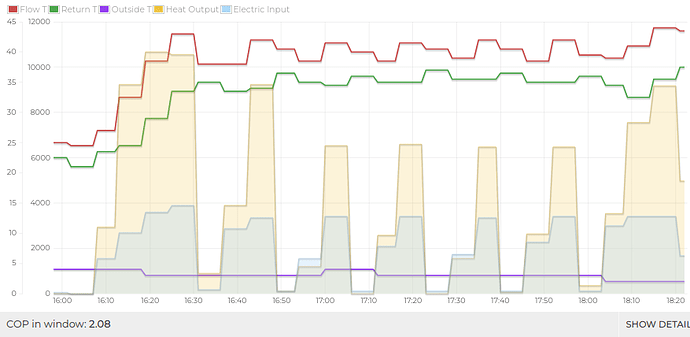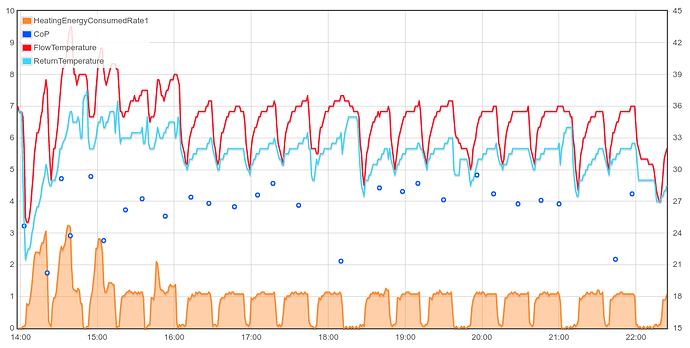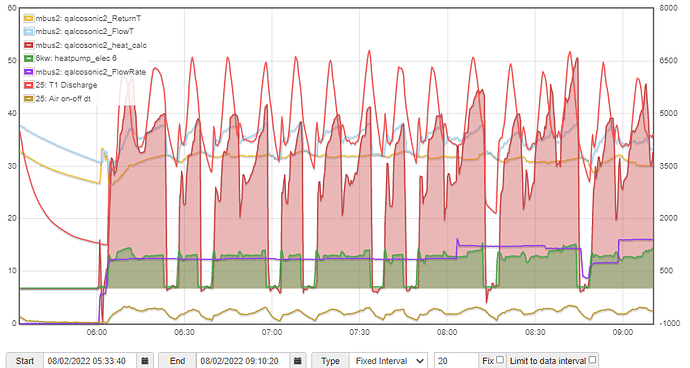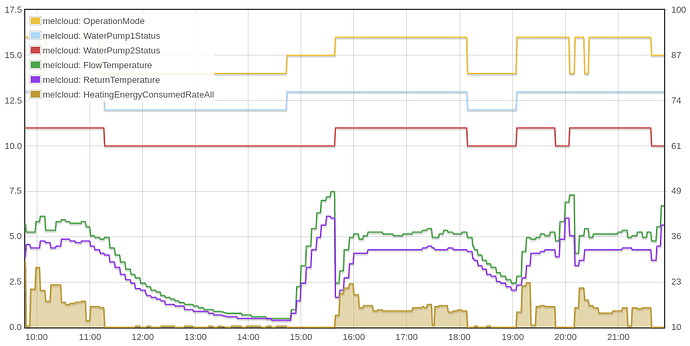I would be interested to see some power, heat-output and flow/return temperature graphs of new model Ecodan. Also interested in ‘running information’ values off the controller. Seeing how any ASHP models modulate in different conditions is always interesting. Its quite crucial to getting good efficiency.
Mine has R32 stamped on the outside. 8.5kW unit installed last autumn. Here is a graph of it resuming after heating a tank of water and settling down to what I think is modulating:
(CoP estimate for that period was 3.08 - not sure why I cut it off)
Here is a graph of it an occasion where I think it failed to modulate and cycled instead:
I have not yet spotted a pattern for modulation versus cycling, but I have started recording a few more variables a day or two ago that may help, plus all the defrosts rather hinder trying to see steady modulation while it’s 1-2°C.
Let me know what values you’d like and I’ll see what I can get.
That is interesting… thanks
Well… I don’t know why it cut off before the steady-state period. Is that really 11kW output at start? There could be a plausible reason why a compressor might occasionally go to medium speed first for oil-return to compressor. That said, seemingly not all models do. Anyhow, I see no reason why it should stop and restart. My one does the same at times. Your flow-return dt looks a little high at almost 10 degrees during max heat, BUT that should be just about OK. Maybe flow-rate a tiny bit low??
On your cycling graph, the COP in the middle section looks low… less than 1.5??, so why can it not settle down with an output of say around 4kW (50% of 8kW), and cycle less. What is it like when say 10 degrees outside? Its odd that it is peaking at over 8kW over a section where the average need seems to be somewhere about 3kW.
Back to your first graph, at 06:25, the output drops to 3kW, but input remains high at 1.3-ish. I would be interested to know what your ‘Running Information’ readings for 004 and 012 were on the controller. at that time. However, it is extremely hard to catch these periods.
Who is to know what is real? These are numbers from pymelcloud, as discussed elsewhere, so the best I can do without adding my own sensors.
How can I tell?
Nearly. The worst I’ve yet found for any single cycle is 1.52.
I’d love to know. I’ve only been recording on emoncms a few weeks, so I’ve not recorded many periods of 10 degrees outside yet! So far only a half-hour I found on 11th January:
I will try if I spot the heatpump settle down one day, unless there’s some better way.
The readings should be good enough for comparisons. Not as accurate as a heat meter etc.
Re flowrate. If you go to the service icon, you should be able to find ‘running information’ and if you enter 540, it should give you the flow rate in litres/min. I think the data sheet suggests 11 to 24lit/min. I tend to look at the difference between flow and return to gauge if flow rate is about right. I like 5 degrees. For most of your running, the dt looks slightly high, but not enough to make a measurable difference… unless you intend to run a full-power a lot.
That last graph is interesting at 10C outside and 35 flow. it has stabilised very low output, but COP should be a lot better. That said, the measurements are a bit approximate, and are probably inaccurate in conditions like this… I dont know.
Does this mean that the Sontex Superstatic 449 is not a heat meter or that melcloud getting its readings from somewhere else or just that melcloud’s recently-introduced 5-minute-interval reporting isn’t great?
Thanks. 18, it says at the moment, where it’s reported as consuming 1380W to produce 4260W heat with 41°C flow and 36°C return, having run fairly steady for the last hour.
Ah, so what does your Sontex connect to? What is it doing mmsp?
As I understand it Melcloud uses the same power and heat-output values that are displayed on the panel as Consumed and Delivered Energy. You dont need a heat meter (e.g. Sontex or Kamstrup) for the Ecodan to estimate energy values.
So I finally got up into the loft to check and it appears to have wires to the flow and return pipes and the cylinder (I assume these are temperature sensors), another big round plate on one of the flow or return pipes and a big wire to the ecodan square box cover. That last might only be power but it looks a bit of a big cable for that. I think it’s for the MMSP but I don’t really know.
On the down side, I seem to have a slow sealant leak from one of the pipe sensors, which surely shouldn’t be happening 4 months after installation, so now I get to call my installer.
Here’s a chart from my unit for comparison [EcoDan 11.2 kW PUZ-WM112VAA]
Outside temperature from 8°C increasing to 10°C, target flow temp 32°C for majority of middle section, CoP about 4.
My heat meter isn’t quite set up right, so CoP (blue dots) is calculated periodically for each whole kWh of heat recorded. My unit seems to only run in 20 minute cycles, though this might driven by the Honeywell room thermostat.
Edit: the minimum it seems to modulate down to is 1 kW - 30% of it’s 3.73 kW rated maximum input.
That is interesting, thanks. Are the ‘offs’ the ASHP stopping rather that thermostat stopping. My Ecodan seems to regularly stop for 4 minutes. Its annoying that it is so brief since if it has stopped because the load is ‘light’, there is often no rush to restart. Looking at the longer stop after 18:00, it looks different. looks like circ pump stopped, so that will be a stast stop. As you say, it could be honeywell unhelpful pulsing. Question is… would it be better to cycle less? If you hold off for longer (somehow), then it might start and rev-up, as it ‘panics’ to get the temperatures back. Interestingly, your input power settles to 1kW when on. My 6kW can spend a lot of time cycling at 950W input. Why it does not reduce itself beats me!
I’m interested that the flow-return dt seems to take a while to build up. How near to the heat pump are your sensors? Assuming your flow-rate is constant, you could plot dt as a ‘gauge’ of heat output. This is possibly of limited interest. Is it underfloor? If you had rads, the water would drop much more during ‘offs’, and it would rev-up more at every start. I have seen dramatic stop/start cycling on my unit. It would be so interesting if we could experiment with the first period, and set it going with a fixed input of 1kW. Would the COP be better without the ups and downs and stops. I’m sure it would , but I dont know how much by.
After closely watching the unit performing today, it seems that the ASHP will only run for 20 minutes before stopping for a breather, regardless as what the thermostat says. I think. It could be that the thermostat sends a short call for heat, and then the ASHP has a minimum running time after that point. I can’t quite tell. The main unit shows it’s “Idle” shortly after starting a cycle. I need to investigate further.
{I came across this forum post on another site that talks about my specific thermostat with a heat pump}
Yes, I think I turned down the room thermostat at this point, so it didn’t call for any heat for a little while. Both the main and central heating pumps turned off at this time. Below is a chart for the same period [Feb 7th]:
- OperationMode goes high at the start of each cycle, but only for short periods for most of the day
I’d be interested to see how this parameter varies on other units - WaterPump1Status (main) and WaterPump2Status (heating) drop to zero between cycles when there’s no call for heat - maybe the thermostat cycles get out of sync with heat pump cycles?
- FlowReturnDelta is dt - mean is 3, most often at 3.5, stdev is 1.5
- HeatPumpFrequency (not to scale) is at 75% at the early part, settling down to 30%
The end of each heat pump cycle is almost always 20 minutes after the OperationMode goes high.
If I look back through at previous days, I can find odd occasions when the OperationMode stayed high for a significant period, and the heat pump ran for longer [Jan 31 around 18:00, it ran for over an hour without stopping], but this is rare.
That’s a good question. I’d have expected that longer cycles less often would be better, to save wear on the compressor at least. Maybe I’m seeing EcoDan’s ‘automatic adaption’ at work, deciding that short cycles are better? The performance I’m getting out of it seems reasonable, though I wouldn’t say no to even high CoP!
This seems a good time to point to @MyForest’s thread about turning off the heatpump to improve efficiency - his first chart shows many short cycles (6 per hour!) that he tamed into longer cycles that were less frequent.
The sensors are very close to the indoor unit, with the external unit quite a distance away (about 10m). I do plot dt (see above), and it’s kinda interesting but I don’t know what it tells me. I do know that I very rarely see a dt above 4°, even after the installer reduced the pump speed. (They told me the system is designed to run between 1-3°)
No underfloor; all newly upgrade radiators (mostly K2).
Your stat might be a pulse type (and that might be dip-switch changeable…I dont know), but i think your ‘stops’ are the heat pump. Here (below) is mine in a very bad cycling mode. The stops are always 4 mins, (stat is fully on)
What is your ‘operation mode’?
The relationship between dt and Mitsi control is still a bit of a mystery to me. As such, the dt should not be such an issue, and ideally, we could have variable pumps that adapt to give a dt 4 or 5. I dont see a problem with dt 2.5
How do you get your compressor frequency reading?
I looked at mine yesterday, some of the cycling periods had COP about 4. However, I have a steady period this morning with COP of 5. Clearly, there is a lot of scope for optimising, and what bothers me is that many seem to say… oh well, 4 is quite good… yes, but 5 is much better!
I also looked back at my old 5kW, and it would go into cycling mode if not enough rads were on (as expected) COP drops considerably. I am considering ‘holding it off’ after stops. I would not be hard to have an algorithm to ‘gauge’ actual heat need. It could be a simple as outside temperature.
I get these numbers by scraping data from MELCloud - I have no idea how you’d get these otherwise.
The compressor frequency maps quite closely to the power consumption, as a percentage of the maximum input wattage (datasheet for a 6kW unit says 1.88 kW).
Thanks for sharing what you’re seeing too.
- OperationMode on mine is 2 the whole time that space heating is on, except for when dt falls to 3 or less and then it drops to 0. Image below, but I don’t have dt neatly so show both flow and return.
- My pumps keep running when heat pump is cycling as long as the heating is on. I don’t have any thermostats that call for heat as far as I know. (The ecodan controller might but I largely ignore it.)
- That’s curious about your dt, as well as the installer comment later in your post. The nominal values in the ecodan databook are worked out at ΔT=5°. I didn’t find the minimum for operation. As mentioned, my heat pump starts cycling if dt is 3 or less, so I suspect a system designed for 1-3° will be troublesome. That might be what you’re seeing, but I think it’s more likely that the Honeywell thermostat is a simplistic on/off one cycling to give a modulation-like effect in boilers that don’t modulate. It could well be unsuitable for use in a heat pump system, as that other site suggests.
I am noticing that people rarely put COP in context. I suspect I will get very nice COP if I run the unit for an hour in 13°c ambient to produce water at 20°c and ignore the startup, but what’s the point in that? Even knowing the day or time does not help because maybe they had sun when I had thick fog, or they are sheltered when I am in a fen blow.
There’s also the simple problem that there is very little reliable information on how to optimise any heat pump and especially the ecodan where Mitsubishi’s official view seems to be to trust their auto-adaptation super-thermostat mode. I suspect they would say that I simply didn’t give it enough time to learn (re-learn?) our house and preferences after the November firmware update before changing to curve mode with timers, but it really did look like it was going expensively wrong to me, increasing costs by 50% overnight.
And I suspect setting and tuning the weather compensation curve is as much as most people will be willing to do, if that. We’re all a bit niche, aren’t we, setting up software to monitor and/or control our heating systems? Is there enough of a market for any manufacturer to encourage (rather than tolerate) access by things like Home Assistant, even? Let alone integrate more advanced node-red or scripting-style logic into their own controllers. How much could we save by optimising and so how much time and money is it worth spending on this? Maybe I will do some sums on the back of an envelope later.
I’ve spent the week experimenting with various things, and I can confirm that it is the room thermostat that is driving the behaviour I’m seeing. To summarise, the room stat calls for heat, which triggers the heat pump to start up. [The ‘OperationMode’ I was charting above correlates directly to the signal from the room stat]. If the room is close to the set point, then the call for heat will be short, but the heat pump will continue for the minimum of 20* minutes. [*Actually the minimum can be as short as 10 minutes when the flow temps are high enough]
I’ve experimented with Honeywell’s secret settings, but can only select 3, 6, 9 or 12 cycles per hour. Problem is, all of these divide into 20 minutes neatly.
From what I’ve read elsewhere, 20 minute cycles aren’t necessarily bad for heat pumps, and performance shouldn’t suffer too much. But I think I can perhaps get better CoP with longer runs. Maybe. I need to run some experiments for a few days before I’m sure.
As I’ve learnt from the other thread, the room stat will only modulate when the temperature is within 1.5° of the set point. For larger differences, it will send a persistent call for heat. This made me realise that I had my heating programs setup backwards: I was setting the early morning to be warm-ish, switching to a higher temperature by late morning (house is occupied all day). What I actually need is for a higher startup temperature to get things going, then drop down a degree for the rest of the day. With this setup, I got a solid 2 hour run this morning!
Will continue to monitor and fiddle with things to try and find the most optimal configuration…
Related discussion: Advice on air-source heatpump/thermostat settings?
Is the demand setpoint important for these graphs? AIUI, once the flow setpoint is reached the HP switches off?
For a non HP user these are always an interesting read and reinforce that, when setup well HPs perform, but all too often they are badly setup and unless the owner takes times to asses the trends, will continue to do so and cost a fortune to run.
This technology is simply not mature enough to be foisted on Joe Public, who simply wants to set the room thermostat.
The system as installed works “okay”. The ‘TPI’ room thermostat they provided is perhaps not ideal, and maybe a non-TPI thermostat with adjustable hysteresis could possibly do better, but it does what it needs to do. I don’t think I’ll be able to convince them to come back and change it.
The installer also recommended I keep the flow temps fixed at 45°C, whereas I found the built-in weather compensation feature to be much more effective. There’s clearly an incentive for installers (and manufacturers) to configure heat pumps to be as close to what regular people are used to, as not everyone understands how differently they work.
I don’t think it’s the technology that’s the issue here, but insufficient training and understanding of (some) heating engineers. Had it been installed and setup by someone who really understood heat pumps, then it would have performed excellently from day one, and I wouldn’t need* to tinker with it (*that’s not to say I wouldn’t have done anyway, but I’m not a typical home owner).
Good to hear that you are getting to grips with it. It can take a lot of time. I guess those ‘helpful’ boiler stats are hindering many heat pumps out there. As you say, cycling isnt always bad, and during a ‘off’ period, heat is still transferring from radiators to room as they cool to 25C or so. When the system re-starts the heat pump ‘sees’ colder water for the first 5 mins of so, and COP is extremely good then. Ideally, heat pumps would have a wider kW output range (lower minimum kW). This is the problem with large capacity heat pumps… they might need to operate at higher flow temperature followed by off periods. Quite tricky to set up if you are after the best overall COP
To add to what you have said Tim, yes performance can be ‘good’ even if minimal tweaking, of a system. but often, a bit of careful setting change can make a worthwhile improvement. I don’t used my weather comp because it tends to heat more than I want on cold frosty nights (I don’t have good night set-back option). I adjust the flow temperure from 32 to 38 (ish) depending on my need. It often sits at 35C. I tend to set it low enough so that that some stats barely hit their set-point. I have thought about making a little controller that modifies the fixed set-point automatically. It would not be too hard to work out an algorithm to do that, and it is roughly what the ‘room target’ does… it tries to keep water temperatures low, and just adequate to keep the main room warm. The problem is if you don’t have enough radiators in circuit at any one time, and the water temperatures rise too quickly… giving rise to cycling. It would be nice to have a control to increase the ‘off’ period during the times that you only need low heat. An ‘off’ delay based on outside temperature could be a simple way of doing it.
Not exactly, as far as I can tell: my heatpump switches off once the flow setpoint is reached AND the return is less than 3°c below it; or if the flow temperature exceeds the setpoint at minimum power.
There’s a post from Graham Hendra on another site claiming that one reason for heating flow temps being set high in the UK is to reduce the number of calls from disgruntled customers claiming the heat pump isn’t getting the radiators hot. Basically, it was easier to waste customer money than explain/teach/convince people that large warm radiators emit the same heat energy as small hot ones.
That could be the root of the problem I was having with the ecodan’s “auto-adaptive” mode and its ever-rising flow temperature. I see no way of discovering what size house it expects, or telling it what size house it is heating. Maybe it would learn… but I chickened out seeing the meter spin fast.






